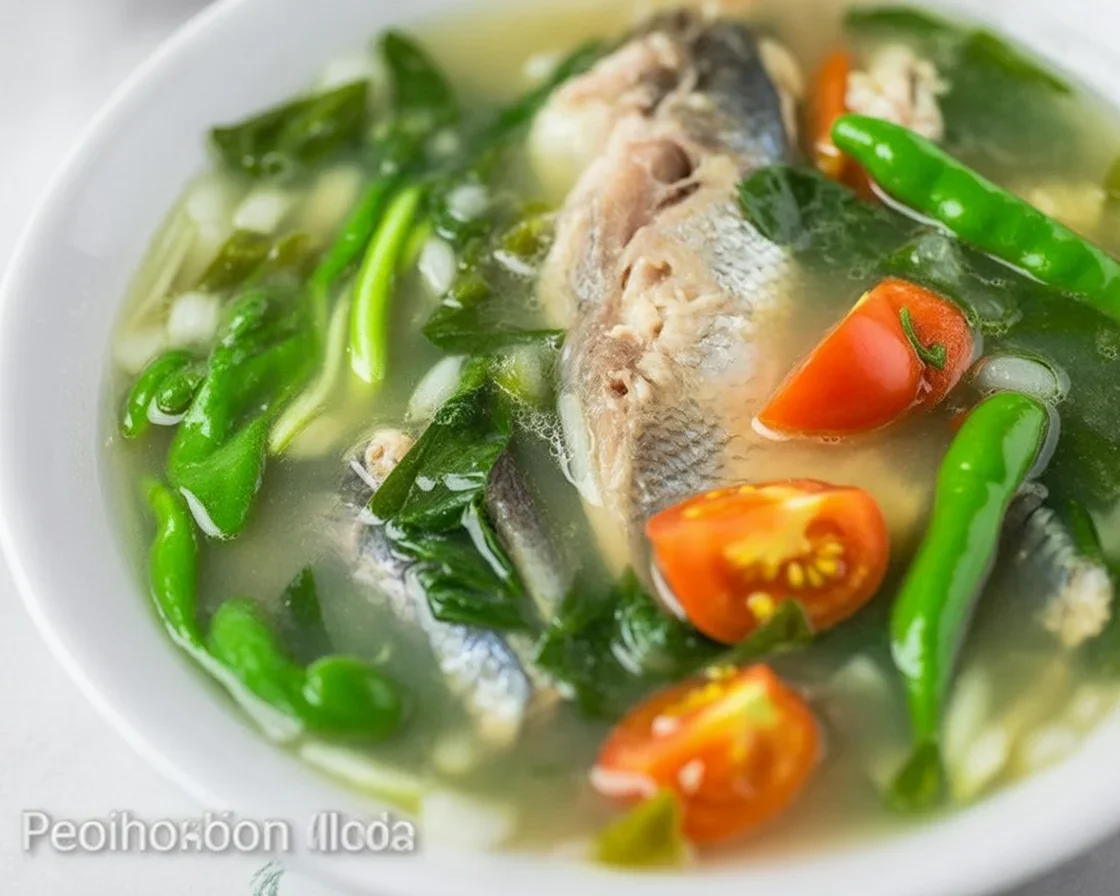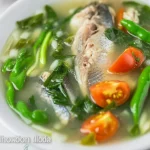- What is tinolang isda?
- Choosing fresh fish
- Preparing ingredients
- Cooking ginger broth
- Adding vegetables
- Seasoning
- Serving hot
- Common Questions
- Ready for a bowl of pure comfort?
Filipino tinolang isda always shows up when I’m desperate for something fuss-free, nourishing, and (let’s be real) a break from heavy, oily dinners. You know those evenings? You open the fridge to the sad reality of random veggies, plus a fish staring back at you? Don’t sigh. This dish always saves my day. It’s not just super light on the stomach, but it’s like a cozy hug after a long, sticky Manila day. Sometimes I swap chicken for fish, or level it up with weird veggies I didn’t know what to do with. Got curious palates at home? Honestly, this and Filipino tinola with spinach chicken is the non-intimidating intro for picky eaters. And if health is your vibe (as it should be), you’ll love the vibe at healthy Filipino recipes.
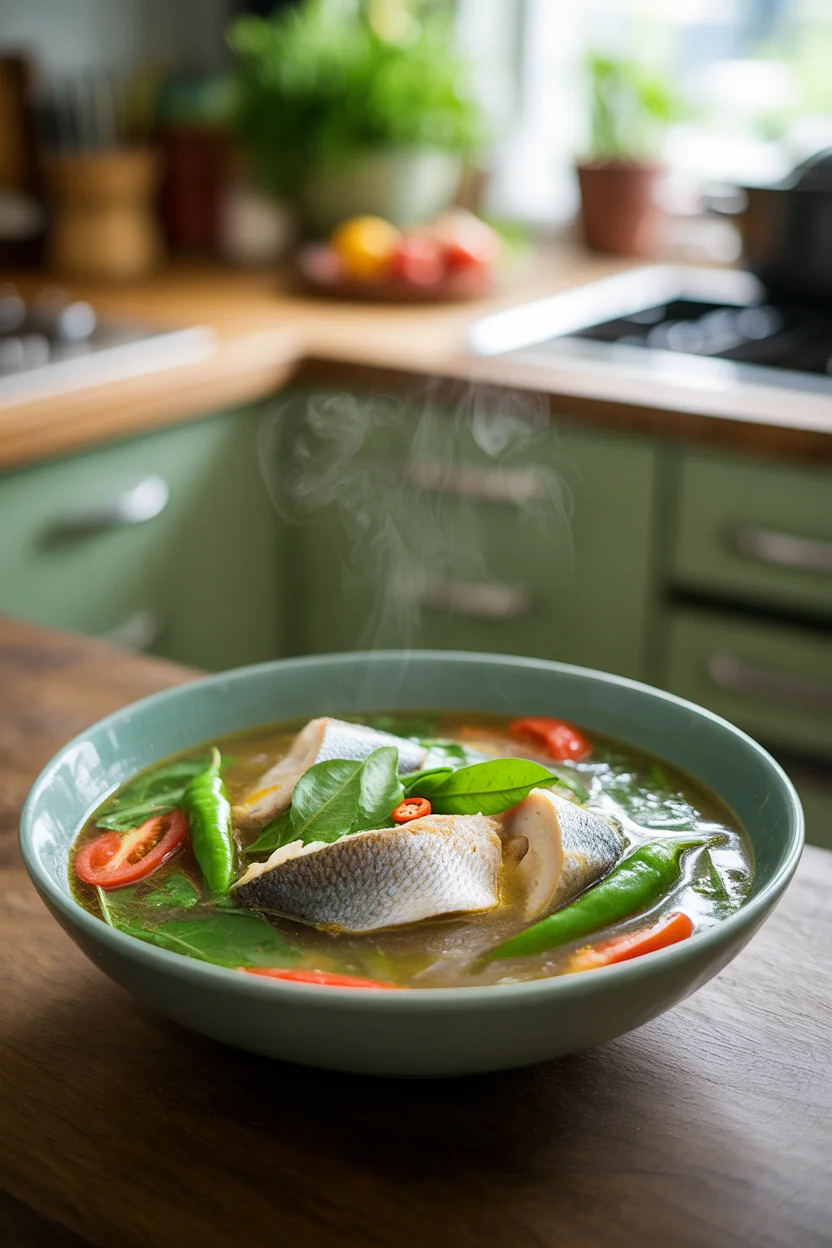
What is tinolang isda?
Think of tinolang isda as the sea’s version of grandma’s ginger soup. It’s a classic Filipino recipe—basic, humble, but crazy comforting. Tinola usually uses chicken (I know, shocking), but with fish, the broth gets super clean and lightly sweet instead of being all meaty and rich. Basically, you simmer fish in a simple ginger-onion broth. Toss in fresh vegetables. Season light. Call it dinner.
The genius of tinolang isda: you don’t need chef skills or even a bunch of fancy stuff. Just honest ingredients. Usually, folks pick bangus (milkfish), tilapia, or even lapu-lapu when feeling bougie. Roots? Ginger’s the real king. Then you’ve got greens—sometimes chili leaves, sometimes malunggay. It really depends on what’s bouncing around in your crisper drawer. Oh—if you want an upgrade, use a bit of fish sauce (patis). It does something magic. Ask my titas.
It’s not really about the recipe, it’s about what’s fresh and what you crave. Cold, rainy day? Double ginger. Kids at the table? Keep it super mild and pair with kid-friendly Filipino recipes. Someone says they’re sick? Everyone asks for tinolang isda. It’s just that kind of dish.
I used your tinolang isda trick last stormy night—my kids finished their rice for once! Just simple, light, but my husband said it tasted like home. –Lorie, Cebu
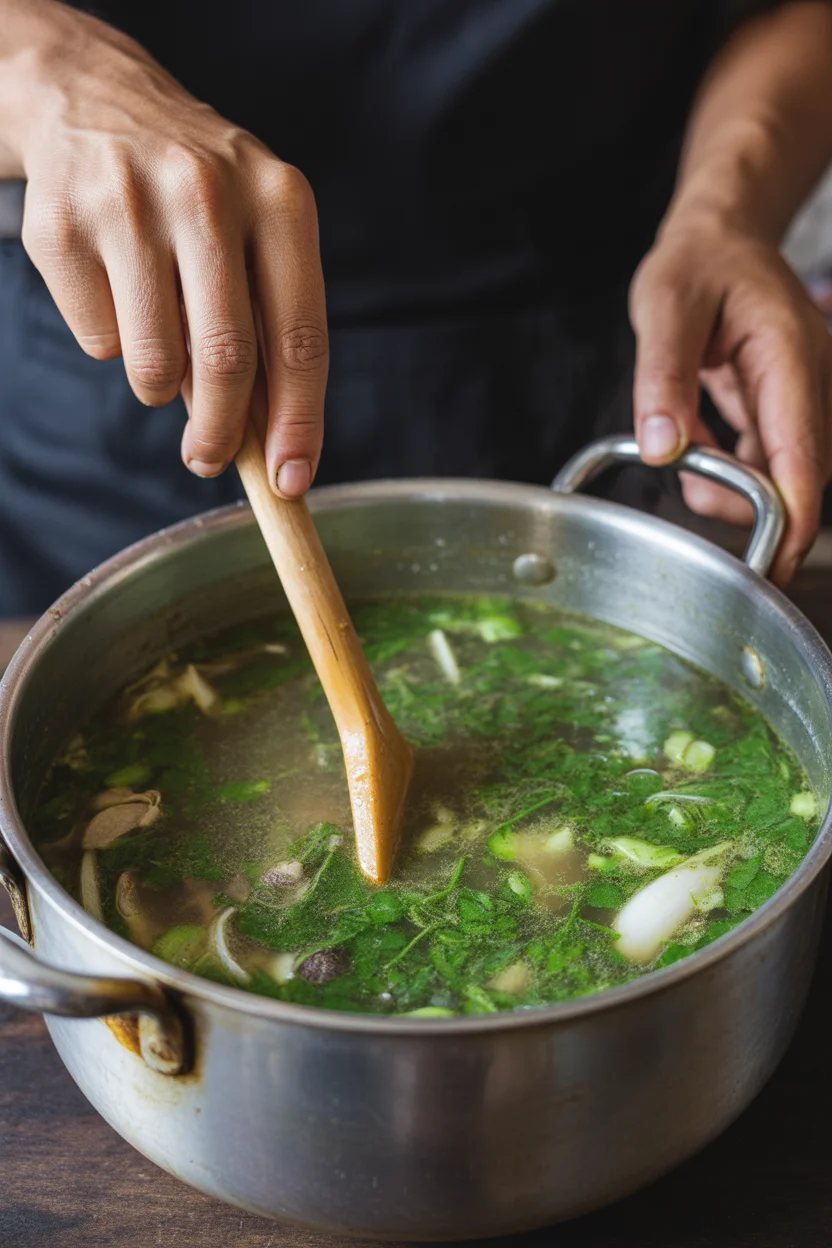
Choosing fresh fish
Alright, let’s talk about the fish—because if this part flops, there’s no saving it. Go for what’s stunningly fresh at the market. Honestly, I sniff the fish first. If it’s got zero fishy smell, that’s your winner. If you’re landlocked or in a rush, frozen fillets can work, but they won’t hit quite the same. Ask the vendor for bangus if you’re feeling classic. Tilapia works; lapu-lapu’s for when you want bragging rights.
Check the eyes—look for glassy, not cloudy. Press the flesh with a finger, like testing for ripe avocados. It should bounce back, not leave a dent that lingers. Scales? Shiny. Gills? Should be bright red, not brown or slimy. Don’t overthink the fish species, by the way (unless you’re swearing allegiance to something). You do you.
One more thing: Buy the fish whole if you can, and have it cleaned on the spot. Tell them “pa-dress po” and they’ll gut it for you. Makes your kitchen life way easier. Pro tip: Save the fish head for extra flavor in the broth.
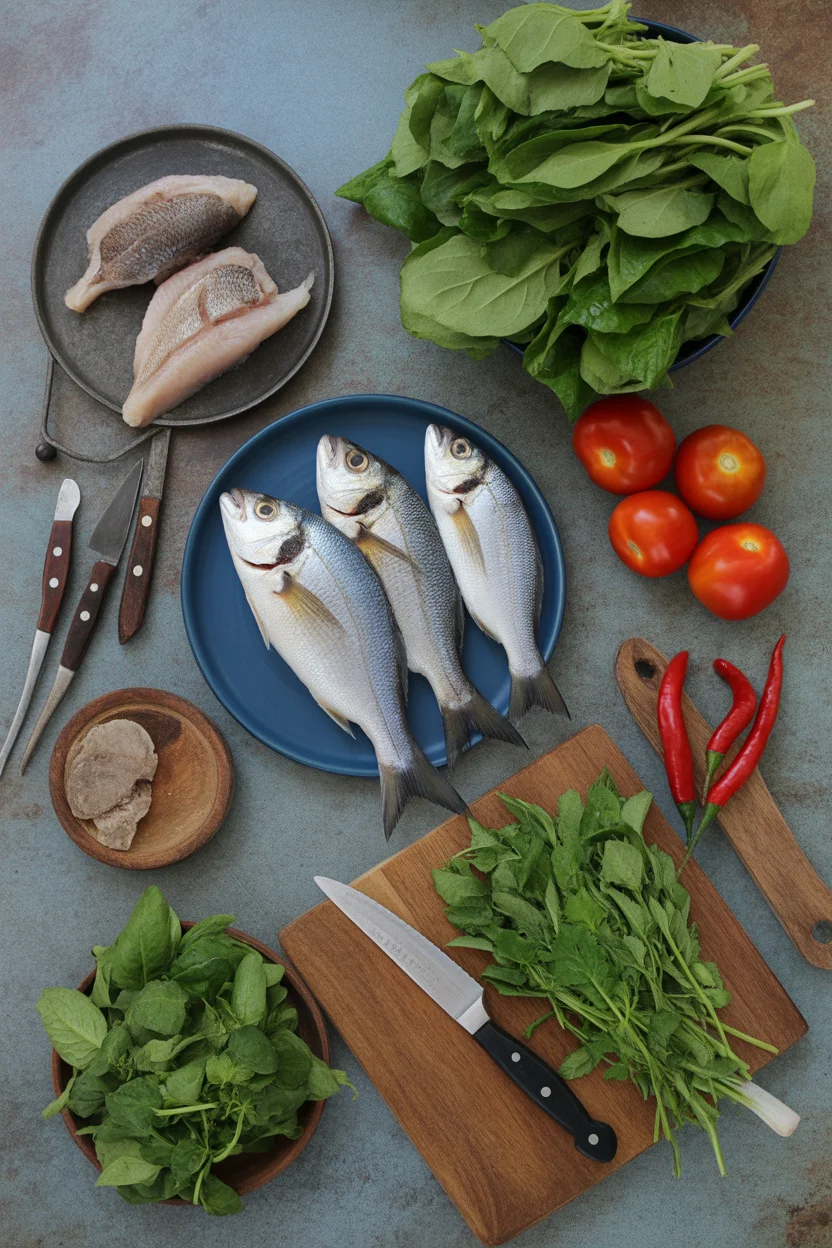
Preparing ingredients
Don’t panic, the list is easy. Slice up some ginger (seriously, a generous chunk), an onion, and garlic if you want. Say a quick thanks to fresh produce. Tomatoes—if you like a little tang—are just bonus flavor.
For greens, malunggay (moringa) leaves are classic. Chili leaves? Lovely. If you can’t find those, bok choy or spinach are honestly great swaps. I toss in green papaya or upo (bottle gourd), cut thinly. Even sayote works. Just don’t add veggies that fall apart too fast; you want a tiny crunch.
If your ingredients are looking a little tired, soak the greens in cold water before you add them. Breathe some life back. And with the fish, rinse it gently under cold water, pat it dry. Don’t skip this. Bones? Yes, some folks remove them, but my family loves to pick around them. It makes it a whole experience (messy but fun).
While you get these ready, start boiling water for broth. Multi-tasking’s half the battle!
Cooking ginger broth
Let’s be honest. The broth is the soul of tinolang isda. Weirdly, the trick is not to rush. Start with a splash of oil in your favorite soup pot (mine’s seen better days). Sauté ginger slices until your kitchen suddenly smells amazing. Throw in onions. If using garlic, add it now.
Once these soften and you’re tempted to just eat them on rice, pour in enough water to cover your fish and then some. If you want a milder taste, use more water. Bring it to a gentle boil, not a wild, bubbling one. This is not a rolling boil situation.
Once the broth simmers, slip in the fish. Try not to break it apart—nobody likes chasing flakes in their soup! Lower the heat, let it bubble softly until the flesh turns opaque. I’d say maybe 8-10 minutes max, but trust your eyes. If your fish is thick, go for a couple more minutes. While that’s bubbling, get your veggies prepped for their turn. The smell is honestly the hardest part—it makes you so hungry.
Adding vegetables
When the fish is half-cooked, slide in your chosen veggies. Hard ones like green papaya or upo first; leaves go in very last. You want them barely wilted, not sad and soggy. Watch the color go from dull to bright green—it’s like the soup wakes up.
Try not to stir after adding the fish and veggies. Gently push things down so they’re covered by the broth, don’t bash them around. Seriously, resist the urge. The soup tastes best when you don’t overwork it. I sometimes cover the pot for a minute or two, let the steam help along.
Once everything looks perfect (leaves glossy and green, veggies fork-tender), you’re pretty much done. Remove from heat before you overcook them. Patience at this stage gives you the brightest flavors.
Seasoning
Here’s where you bring it all together. Add a little salt—don’t dump it in, just a pinch at a time. Taste-test along the way. Some swear by patis (fish sauce), but use it gently or you’ll overpower the gentle broth. No fancy spices needed; let the ginger and fish do all the heavy lifting here.
If you need more depth, squeeze a tiny bit of calamansi or drop a shard of green chili in for gentle heat. Feel free to play around—my Lola swore by fresh cracked pepper while my mom skips it. I keep it light so the fish’s sweetness pops. The goal here is clean, not muddy.
After seasoning, let it sit for a minute or two. Somehow, it sort of marries the flavors together. Don’t skip this tiny part, even if you’re starving—it’s worth it.
Serving hot
This is my favorite part. Tinolang isda is flat-out best ladled hot, straight from the pot. Here’s how I serve it at home:
- Lay fish gently in a deep bowl, then pour steaming broth and veggies on top.
- Always, always serve with a big bowl of steamed rice. It soaks up all that healthy broth.
- Pair with a dipping side—maybe spiced vinegar or soy sauce with chili for grownups.
- Eat quick. This dish loses spirit if it lingers too long on the table.
First spoonful is magic, honestly. It’s Filipino comfort food on a rainy day or after a tiring workweek. Don’t be shocked if there are zero leftovers.
Common Questions
What kind of fish is best for tinolang isda?
Bangus or tilapia is classic, but use whatever’s fresh—lapu-lapu’s fancy but worth it. Just don’t pick bony, dry fish.
Can I use frozen fish?
You can. Not my first pick, but as long as it’s thawed and patted dry, it’ll cook alright.
Do I need malunggay or chili leaves?
Nope! Use spinach, bok choy, or even pechay. Don’t stress—greens are flexible.
How long can I keep leftovers?
Maybe one to two days, max. Fish spoils fast. Pop leftovers in the fridge quick.
Can I make this spicy?
If you love heat, toss in a siling haba (long chili) while the broth simmers.
Ready for a bowl of pure comfort?
Tinolang isda proves you don’t need wild ingredients or chef skills to eat super well at home. Just simple, market-fresh stuff and a pot of ginger broth gets you a light, healthy dinner that seriously rivals any five-star restaurant (oh, fight me on that). If you want to explore even more Filipino soups, check out this Fish Tinola Recipe, the easy tips on Fish Tinola Recipe (Tinolang Isda), or get inspired by Tinolang Isda – Panlasang Pinoy. Hope you dive in, slurp away, and add this to your weekday survival kit. It’s simple, honest, and pure Filipino comfort in a bowl.

Tinolang Isda
Ingredients
Fish and Broth
- 1 kg fresh fish (bangus, tilapia, or lapu-lapu) Choose fresh fish from the market.
- 1 tbsp oil For sautéing.
- 1 large onion Sliced.
- 2 inches ginger Sliced into strips.
- 4 cups water More can be added for a milder broth.
Vegetables
- 1 small green papaya or upo Thinly sliced.
- 1 cup malunggay (moringa) leaves Check notes for alternatives.
- 1 cup chili leaves Use as an option; substitute with bok choy if necessary.
- 1 large tomato Optional for added flavor.
Seasoning
- to taste salt Add gradually.
- to taste fish sauce (patis) Use sparingly to avoid overpowering the broth.
- 1 piece calamansi For added zest.
- 1 piece green chili Optional for heat.
Instructions
Preparation
- Choose fresh fish and pat it dry.
- Slice ginger, onion, and prepare the vegetables.
- Rinse greens and soak if needed for freshness.
Cooking Broth
- In a pot, heat oil and sauté ginger and onion until fragrant.
- Add water and bring to a gentle boil.
- Once boiling, add the fish and simmer until the flesh turns opaque.
Adding Vegetables
- Add hard vegetables like green papaya first and cover.
- Then, add softer greens last to maintain their texture and color.
Seasoning
- Season with salt and fish sauce, tasting as you go.
- Add calamansi or green chili for extra flavor.
- Allow the soup to sit for a minute to meld the flavors.
Serving
- Ladle the soup into bowls, placing fish gently and pouring broth over.
- Serve hot with a side of steamed rice.
- Enjoy immediately for the best flavor and experience.
